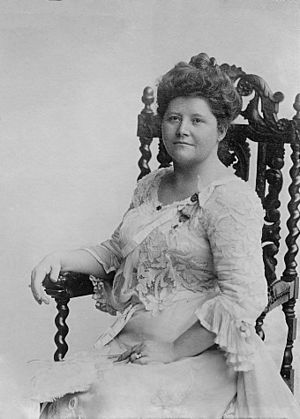Cornelia Cole Fairbanks facts for kids
Quick facts for kids
Cornelia Cole Fairbanks
|
|
|---|---|
 |
|
| Second Lady of the United States | |
| In role March 4, 1905 – March 4, 1909 |
|
| Vice President | Charles W. Fairbanks |
| Preceded by | Edith Roosevelt |
| Succeeded by | Carrie Sherman |
| President General, National Society Daughters of the American Revolution | |
| In office 1901–1905 |
|
| Preceded by | Mary Margaretta Fryer Manning |
| Succeeded by | Emily Nelson Ritchie McLean |
| Personal details | |
| Born |
Cornelia Cole
January 14, 1852 Marysville, Ohio, U.S. |
| Died | October 24, 1913 (aged 61) Indianapolis, Indiana, U.S. |
| Resting place | Crown Hill Cemetery |
| Spouse | |
| Children |
|
| Education | Ohio Wesleyan University (BA) |
Cornelia "Nellie" Cole Fairbanks (born January 14, 1852 – died October 24, 1913) was an important woman in American history. She was the wife of Charles W. Fairbanks, who served as the 26th Vice President of the United States. Because of her husband's role, she was known as the second lady of the United States from 1905 to 1909. Cornelia Fairbanks was a strong supporter of women's rights, especially the right to vote. Many people saw her as a leader who helped open doors for women in American politics.
Contents
Early Life and Family
Cornelia Cole was born in 1852 in Marysville, Ohio. Her father, Philander Cole, was a state senator in Ohio. Her mother was Dorothy Witter. Cornelia went to the Ohio Wesleyan Female College and earned her degree in 1872.
In 1874, she married Charles Fairbanks. They had met at Ohio Wesleyan while working on the school newspaper. Cornelia and Charles had five children:
- Robert Fairbanks
- Richard M. Fairbanks
- Adelaide Fairbanks
- Warren Charles Fairbanks
- Frederick Cole Fairbanks
After they married, Cornelia and Charles moved to Indiana. Charles started working as a lawyer. Cornelia helped him with his law practice and encouraged him to get involved in politics.
Important Activities and Roles
Cornelia Fairbanks was very active in her community and in national groups.
Founding the Fortnightly Literary Club
In Indianapolis, Cornelia helped start an all-women's group called the Fortnightly Literary Club. She was the first president of this club from 1885 to 1888. During this time, she also worked on the State Board of Charities, helping people in need.
Life in Washington, D.C.
When her husband became a U.S. Senator in 1897, Cornelia and Charles moved to Washington, D.C.. In 1899, she organized a trip to Alaska for a group called the British and American Joint High Commission. Soon after, the city of Fairbanks, Alaska was named after her husband.
Leading the Daughters of the American Revolution
In 1901, Cornelia was chosen to be the President General of the National Society of the Daughters of the American Revolution. This was a very important leadership role. She served two terms and helped raise money to build the society's Memorial Continental Hall in Washington. In 1907, she helped start her own local chapter of the Daughters of the American Revolution. She was also involved with the George Junior Republic movement, which helped young people.
Travels and Legacy
After her husband finished his term as Vice President, they traveled around the world in 1910. They even attended a special event at King Edward VII's court. The dress she wore to this event is now kept at the Smithsonian Institution.
Cornelia Fairbanks was a strong supporter of Protestant Christianity and helped with missionary work.

Cornelia Fairbanks passed away from pneumonia in 1913. She was survived by her children, her husband, and her mother. She is buried next to her husband in Crown Hill Cemetery in Indianapolis, Indiana.
Cornelia Fairbanks' Lasting Impact
Cornelia Cole Fairbanks was seen as a powerful and smart leader behind the scenes in politics. She helped make it easier for women to become leaders in the United States. Because of her important role with the Daughters of the American Revolution, some people even thought of her as being like a female President of the United States.
She also helped build the second Women's Club in Indianapolis. She was known for being both feminine and a strong supporter of women's rights. Historically, she is remembered as someone who paved the way for American women in politics during the 20th and 21st centuries. During her time, she was one of the most well-known women in the United States and was considered as clever a politician as her husband.

